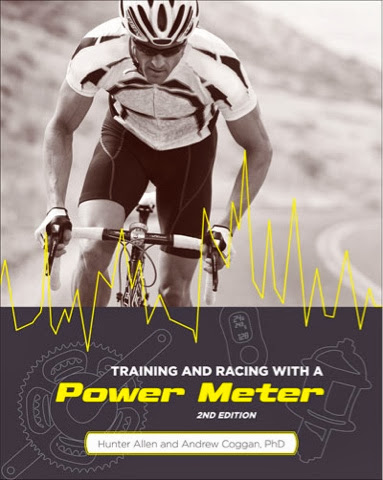Power Meters are fun to train with.
Many triathletes beg Santa for one of these instruments so I’ll share a few thoughts from my experience. I received mine in 2012 and thought it would make me faster for Ironman Wisconsin. However, I didn’t power test (or adjust zones) during that entire build (2/2012- 10/2012), and constantly questioned why my numbers weren’t seeming “right”. I used zones for months that were likely not current and I didn’t learn the benefits and uses of proper power training until a few weeks before my iron race. I thought I was “too caught up in the numbers” but I just wasn’t empowered with the knowledge of how to use the data. Since then my learning and training has come a long way.
Power Meters can be an insightful device and handy tool as you journey closer to your bike potential, but I learned in my Ironman Wisconsin build that you cannot just strap a power meter on to your bike and expect to make gains just by owning it and recording data. Really, just having it is not enough.
You actually have to use the tool and apply the data and update it based on the body’s response continuously. I’ve since been learning more about training with power and my current coach uses power closely in my training by giving me specific numbers to hit, testing my progress regularly AND helping me develop strategies incorporating power. He knows how to empower me to use the data to enhance the training process. The power meter can reveal the true story of your triathlon training. It can uncover the scoop of each interval, session, block of time and even your overall season.
For in depth reading on the topic look up Andrew Coggan and Hunter Allen’s “Training and Racing with Power” If you become a data geek upon reading just embrace the quality and thank me later!
You could also soak in the lighter reading Joel Friel “Power Meter Handbook”.
My rudimentary Power Meter Takeaways are:
1. It makes the training process fun and interesting! The data and numbers is just part of the excitement of training.
2. Power adds value to your training. It can make you faster through precision and purpose in training. So I hear.
3. The numbers provide more intel to your race day pacing strategy.
4. It’s a more accurate measure of performance than speed or even heart rate. (I use both power and heart rate). On a windy and hilly day at 17mph you could be working harder than a 22mph flat tailwinds kind of ride.
5. Power data can help you see your training patterns and big picture of your season build. This is done with the ability to assign a training stress score to each workout and track the “training load” over time. Very handy when assessing fatigue and peak builds.
6. Having more feedback and data about your training is a great tool for post evaluation, progress monitoring and motivation during the actual sessions.
7. Winter is here and riding indoors with goal power numbers to hit instead of going by feel makes the sessions feel like a game. Heart rate is also helpful but heart rate lags whereas power is instantaneous feedback.
8. The Performance Management Chart is a beautiful bonus and benefit. If all data is logged and scored, this tool in the training peaks log can display your fitness dancing with fatigue on blue, yellow and pink lines on a chart. You can capture the story of your entire training build In one amazing picture. You can watch your fitness climb and see it all before you in one simple page. This has converted me into a full on data geek. I love it. Yes, I WILL share my own PMC after my iron in 2014 so stay tuned.
For now here’s an example from Training Peaks
Full commitment to using the tool and/or having a coach or mentor willing to take the time to make it a positive and educational part of your training is key. Using power to train effectively can take you far. At least that is my hope for this upcoming season. I say this from the experience of my own training mistakes of 2012. I did gain from using it for intervals indoors but I didn’t leverage the full benefit of the tool until after that last ironman.
If you (or Santa) invest in a power meter, use that tool for all it can do for you! It’s so much more than a race day pacing screen. It’s not as simple as strapping on a watch or computer. Learning to ride steady with power takes time to master and using the data to make gains is also important.
I want to learn to pace with the power meter this season to help me have a faster ironman bike split and be able to execute a solid run. I want to track my training stress scores, so I am doing the work in the correct zones and I want to learn all I can about this tool while I build a beautiful individualized PMC chart!
My most recent issue is a power and fit issue. I tested at the end of my training block (period of a few consequence weeks of building) with a road bike. I trained consistently on the bike for another training block and then tested with my TT bike using the common 20 minute test protocol. I was rested and ready but I lost 28 watts between my road and TT bikes tests. My understanding is that most people (from my FB pals) lose 0 – 10 watts between bike styles. 28 is a concern. I am confident I haven’t become less fit. I know I didn’t test fatigued or have an “off” day. My HR indicates I worked a few beats harder but with lower power numbers.
My next step is to look at the bike fit itself. When down in aero you can afford to lose some power since you’re in a faster wind slicing position but 28 is too many. It takes less energy to go faster when you are cutting through the wind all aerodynamic. However probably not 28 watts worth.
Regardless, I will continue to train consistently and hope to raise my numbers through getting stronger on training and dialing in a better bike position. I want to be aerodynamic on the bike but also be able you harness the power to the pedals.




